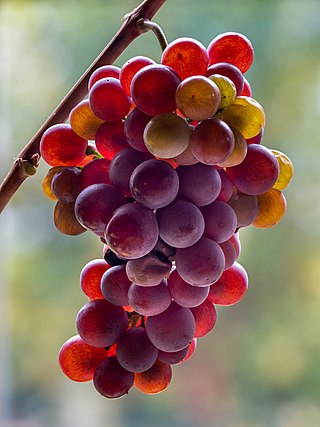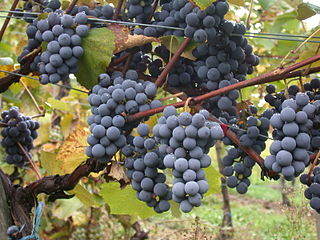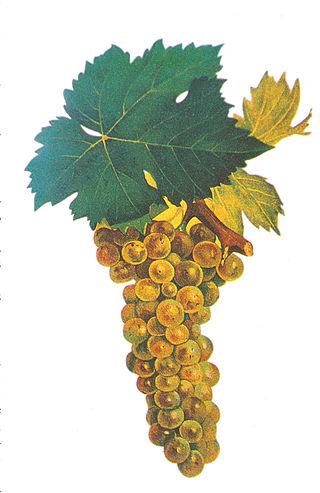Related Research Articles

Cabernet Sauvignon is one of the world's most widely recognized red wine grape varieties. It is grown in nearly every major wine producing country among a diverse spectrum of climates from Australia and British Columbia, Canada to Lebanon's Beqaa Valley. Cabernet Sauvignon became internationally recognized through its prominence in Bordeaux wines, where it is often blended with Merlot and Cabernet Franc. From France and Spain, the grape spread across Europe and to the New World where it found new homes in places like California's Napa Valley, New Zealand's Hawke's Bay, South Africa's Stellenbosch region, Australia's Margaret River, McLaren Vale and Coonawarra regions, and Chile's Maipo Valley and Colchagua. For most of the 20th century, it was the world's most widely planted premium red-wine grape until it was surpassed by Merlot in the 1990s. However, by 2015, Cabernet Sauvignon had once again become the most widely planted wine grape, with a total of 341,000 hectares (3,410 km2) under vine worldwide.

Pinot gris, pinot grigio, or Grauburgunder is a white wine grape variety of the species Vitis vinifera. Thought to be a mutant clone of the pinot noir variety, it normally has a pinkish-gray hue, accounting for its name, but the colors can vary from blue-gray to pinkish-brown. The word pinot could have been given to it because the grapes grow in small pinecone-shaped clusters. The wines produced from this grape also vary in color from a deep golden yellow to copper and even a light shade of pink, and it is one of the more popular grapes for skin-contact wine.

Pinot Meunier, also known as Meunier or Schwarzriesling, is a variety of red wine grape most noted for being one of the three main varieties used in the production of Champagne. Until recently, producers in Champagne generally did not acknowledge Pinot Meunier, preferring to emphasise the use of the other noble varieties, but now Pinot Meunier is gaining recognition for the body and richness it contributes to Champagne. Pinot Meunier is approximately one-third of all the grapes planted in Champagne. It is a chimeric mutation of Pinot: its inner cell layers are composed of a Pinot genotype which is close to Pinot noir or Pinot gris; the outer, epidermal, layer is, however, made up of a mutant, distinctive, genotype. Pinot Meunier was first mentioned in the 16th century, and gets its name and synonyms from flour-like dusty white down on the underside of its leaves.

Gamay is a purple-colored grape variety used to make red wines, most notably grown in Beaujolais and in the Loire Valley around Tours. Its full name is Gamay Noir à Jus Blanc. It is a very old cultivar, mentioned as long ago as the 15th century. It has been often cultivated because it makes for abundant production; however, it can produce wines of distinction when planted on acidic soils, which help to soften the grape's naturally high acidity.

Grenache or Garnacha is one of the most widely planted red wine grape varieties in the world. It ripens late, so it needs hot, dry conditions such as those found in Spain, where the grape is believed to have originated. It is also grown in the Italian island of Sardinia, the south of France, Australia, and California's Monterey AVA, Paso Robles, Santa Barbara County and San Joaquin Valley.

Sangiovese is a red Italian wine grape variety that derives its name from the Latin sanguis Jovis, "blood of Jupiter".

The Muscat family of grapes includes over 200 grape varieties belonging to the Vitis vinifera species that have been used in wine production and as raisin and table grapes around the globe for many centuries. Their colors range from white, to yellow, to pink to near black. Muscat grapes and wines almost always have a pronounced floral aroma. The breadth and number of varieties of Muscat suggest that it is perhaps the oldest domesticated grape variety, and there are theories that most families within the Vitis vinifera grape variety are descended from the Muscat variety.

New World wines are those wines produced outside the traditional winegrowing areas of Europe and the Middle East, in particular from Argentina, Australia, Brazil, Canada, Chile, Japan, Mexico, New Zealand, South Africa and the United States. The phrase connotes a distinction between these "New World" wines and those wines produced in "Old World" countries with a long-established history of wine production, essentially in Europe and the Middle East, most notably: France, Italy, Spain, Portugal, Germany, Israel, Denmark, Finland, Ireland, the Netherlands, Norway and Switzerland.
Tarrango is a red grape variety used in Australian wine production. This slow-ripening grape was created in 1965 by the CSIRO Horticultural Research Station at Merbein in Victoria, Australia, as a hybrid of Touriga Nacional and Sultana in order to create wines of good acidity, but low in tannin. Its wines are often similar to Beaujolais in style. Requiring an unusually warm climate, it is principally grown in the wine-producing areas of northern Victoria.

The Australian wine industry is one of the world's largest exporters of wine, with approximately 800 million out of the 1.2 to 1.3 billion litres produced annually exported to overseas markets. The wine industry is a significant contributor to the Australian economy through production, employment, export, and tourism.

Saperavi is an acidic, teinturier-type grape variety native to the country of Georgia, where it is used to make many of the region's most well-known wines. It is also grown in Russia and in lesser quantities in Armenia, Moldova, Ukraine, Uzbekistan, Azerbaijan, Australia.

Brown Brothers Milawa Vineyard is a family-owned wine company based in Milawa, Victoria, Australia. Brown Brothers was founded in 1889 by John Francis Brown and continues to be owned and operated by his descendants on the original property. Brown Brothers makes wine from a wide range of grape varieties and into a range of styles.

Muscat Blanc à Petits Grains is a white wine grape of Greek origin that is a member of the Muscat family of Vitis vinifera. Its name comes from its characteristic small berry size and tight clusters. It is known under a variety of local names such as Moscato bianco, Muscat blanc, Muscat Canelli, Muscat de Frontignan, Muscat de Lunel, Muscat d'Alsace, Muskateller, Moscatel de Grano Menudo, Moscatel rosé and Sárgamuskotály.
Plantet is a red wine grape variety that was one of the hybrid grape created by French physician and grape breeder Albert Seibel. While the exact parentage of the grape is unknown, the most popular theories has it as a cross of two Seibel grapes, Seibel 867 x Seibel 2524 with another theory speculating that Plantet's parentage was Seibel 4461 crossed with Berlandieri-Jacquez.

Petit Manseng is a white wine grape variety that is grown primarily in South West France. It produces the highest quality wine of any grape in the Manseng family. The name is derived from its small, thick skin berries. Coupled with the small yields of the grapevine, most Petit Manseng farmers produce around 15 hl of wine per hectare. The grape is often left on the vine till December to produce a late harvest dessert wine. It can develop high sugar level while maintaining acidity, so it is usually incorporated into sweet wines of Jurançon and Pacherenc du Vic-Bilh. The grape is grown primarily in Gascony, Jurançon and around Madiran but has recently drawn interest in New World wine regions like California, North Georgia, Virginia, and Ohio. In May 2020, CSIRO scientists discovered through DNA analysis that Australia's plantings of Petit Manseng, first imported in 1979, are in fact Gros Manseng. The reason is that it is expected to follow Viognier's path to popularity among white wine drinkers. It was already present in Uruguay, when Basque settlers brought "Manseng" and Tannat vines with them to their new home. Despite being easily recognizable as a white grape while true Manseng is a black grape, wine that is Petit Manseng is still normally labeled as just "Manseng". The grape is often left on the vine to produce a late harvest wine made from its nearly raisin like grapes.

Gros Manseng is a white wine grape variety that is grown primarily in South West France, and is part of the Manseng family. It produces dry wines in the Jurançon and Béarn regions of Southwest France. In Gascony it is permitted in the Pacherenc du Vic-Bilh Appellation d'origine contrôlée (AOC), in the Côtes de Gascogne and in the Floc de Gascogne.

Olmo grapes are wine and table grape varieties produced by University of California, Davis viticulturist Dr. Harold Olmo. Over the course of his nearly 50-year career, Dr. Olmo bred a wide variety of both grapes by means of both crossing varieties from the same species or creating hybrid grapes from cultivars of different Vitis species.
Taminga is white Australian wine grape variety that was developed in the late 20th century by viticulturalist and grape breeder Alan J. Antcliff at CSIRO. It is a cross of a previously created crossing Merbein 29-56 and the Vitis vinifera variety Traminer Rot (Gewürztraminer) Like Tarrango, a 1960s crossing between Touriga Nacional and Sultana, Taminga was bred to maintain high acidity levels while growing in hot Australian vineyards. Early results from Taminga show that it can ripen consistently in different vineyard location and produce wines that wine expert Jancis Robinson describes as "commercially acceptable.
Cabernet blanc is a white German and Swiss wine grape variety that is a crossing of the French wine grape Cabernet Sauvignon and the hybrid grape Regent. The grape was bred by Swiss grape breeder Valentin Blattner in 1991. Cabernet blanc has strong resistance to most grape disease including botrytis bunch rot, downy and powdery mildew and tends to produce loose clusters of small, thick-skinned grape berries which can hang on the vine late into the harvest season to produce dessert wines. Today the grape is found primarily in the Palatinate wine region of Germany with some experimental plantings in Spain and the Netherlands. In France, in the Languedoc, Domaine La Colombette is heavily investing in PIWI grapes. Amongst others the Cabernet Blanc in their cuvée "Au Creux du Nid", is gaining wide acclaim.
References
- ↑ Robinson, Jancis (2006). The Oxford companion to Wine, third edition . Oxford University Press. pp. 170. ISBN 0-19-860990-6.
- ↑ Brown Brothers: 12 Facts You May Not Know About Cienna